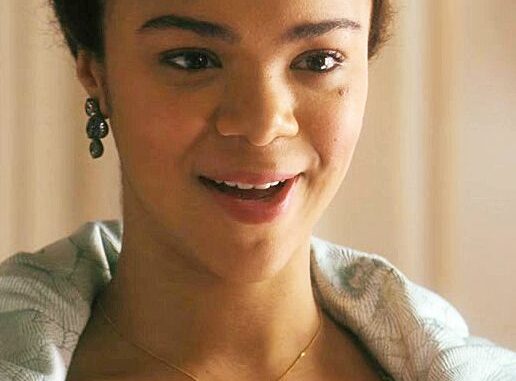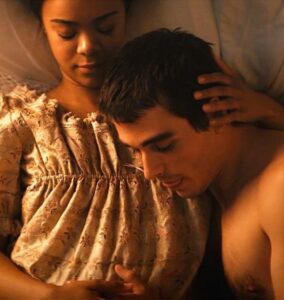
When Bridgerton first made its royal entry onto Netflix, audiences across the globe were immediately captivated by creator Shonda Rhimes’ stunningly inclusive reimagining of Julia Quinn’s novels. Not only did the series spotlight a Black leading man in the form of the dashingly charismatic Duke of Hastings (Regé-Jean Page) but it also flipped the concept of regency power on its head with a formidable Black queen in the form of adult Queen Charlotte (Golda Rosheuvel). Although the representation, which is very rarely portrayed in period dramas, was immediately commendable the series only briefly touched on race and instead left room for audiences to conjure up their own stories as to how Regency England came to be in the Bridgerton-verse. However, the success of the series birthed a prequel tale unlike any other in the form of Queen Charlotte: A Bridgerton Story – a story that tackles racism head-on through the beautifully heartbreaking union of King George (Corey Mylchreest) and Queen Charlotte (India Amarteifio). That weight of their relationship is something show star Amarteifio was actively conscious of during filming.

During an interview with L’OFFICIELI, the young Charlotte actress, Amarteifio, explores how two societies are effectively brought together by the first major interracial marriage in the ton through a concept coined “The Great Experiment.” The name in itself alludes to the attitudes of the people at the time and whilst Queen Charlotte is indeed a work of fiction, the racism and prejudice is a very real aspect of history which is summed up in a nutshell when George’s mother describes Charlotte as ” quite brown.” While Charlotte and George undoubtedly face challenges as the tone quietly disapproves, it becomes more and more apparent that Charlotte possesses an immense amount of influence when it comes to giving Black people a voice and space in elite society. “…She is the object in many people’s paths, but also, she is the plow, almost; she is allowing these people to now be integrated into society,” Amarteifio said. “She is a leader; she is someone who takes on responsibility, unknowingly and knowingly. People listen because she goes against the grain.”
Queen Charlotte Quickly Learns How Valuable Her Position Is
While Charlotte possesses the ability to spark change, it is her confidant Lady Agatha Danbury (Arsema Thomas) that brings it to her attention just how much responsibility is on her shoulders in a powerful speech about her palace walls being “too high.” It is then she is able to lean on George for support in truly enabling the Black community to feel seen instead of shunned. “A lot of it is helped by Lady Danbury and her re-reminding her of who she is, and the power that she holds,” Amarteifio explained. “A lot of that is in George as well, giving her the confidence to lean into that power and not be scared or shy about it, and to remember the role that she holds in society is much bigger than herself.”
Although the pair share a powerful bond on-screen they only spent the equivalent of one week filming together out of Queen Charlotte’s six-month shoot. Nevertheless, Amarteifio said the pair were able to pull from their “own experiences” of being Black women “in an industry in which most of the rooms you walk into are white.” Throughout the show audiences witness a transformation in society through Charlotte’s subtle but impactful actions, such as attending the Danbury Ball and ensuring Lady Danbury’s son inherits his late father’s title. In addition to addressing the rich-in-diversity landscape known in the main series, it also beautifully sets the pace for season three of Bridgerton to further explore and acknowledge just how long a road it was for the ton to get there.
